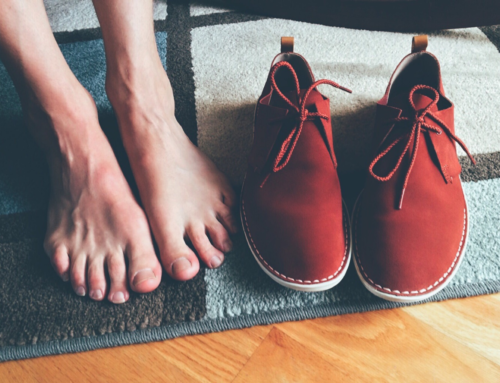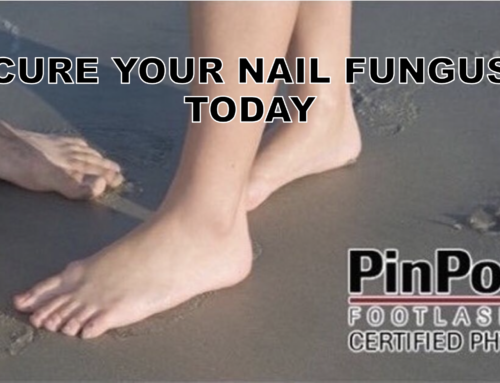When it comes to toenail fungus, many people turn to home remedies as a first line of defense. From applying tea tree oil to soaking feet in vinegar, a plethora of home remedies are deemed effective solutions. But before you embark on a journey of DIY toenail fungus treatment, it’s important to separate fact from fiction.
Let’s explore the truth behind common toenail fungus home remedy myths and why seeking professional solutions like laser nail therapy could offer more effective results.
Myth #1: Nail polish keeps toenail fungus away.
Wearing nail polish does not keep toenail fungus away, which is one of the most common toenail fungus myths. It actually attracts toenail fungus! Applying nail polish traps moisture in, thus creating a dark, warm, and moist environment. This is the perfect environment for fungus to thrive. From time to time, give your nails a break from nail polish. Let your nails have time to rest and breathe to prevent nail fungus. Most importantly, always keep them dry.
Covering nail fungus with nail polish is not a good idea. Nail polish covers your nail and does not allow your nail to breathe. It traps the fungus in the nail, allowing the fungus to thrive and eat away at your nail. It would be best to leave your nails clean and dry. If you really want to wear nail polish, use antifungal nail polish.
Myth #2: Toenail fungus is caused by poor hygiene.
Even if you have the cleanest feet in the world, you can still get toenail fungus. Good hygiene may be important, but there are other risk factors at play. Toenail fungus is very contagious and can be contracted from damaging the nail bed or other underlying health conditions. Even if someone has very good hygiene, they can still get toenail fungus from a pedicure at a nail salon, or from public places where the fungus is common, e.g. public pools and gym lockers.
Poor hygiene may be one of the risk factors of toenail fungus, but it is not the only one. There are other factors that make you susceptible to the infection. People of age usually develop toenail fungus due to their weakened immune system and brittle nails. The fungus is also present in the environment, especially in saunas, nail salons, or swimming pools.
Myth #3: Thick and discolored nails mean you have toenail fungus
Toenail fungus can cause the toenail to be thick and discolored, but thick and discolored nails do not necessarily mean you have toenail fungus. There may be a different underlying condition, such as nail psoriasis. It would be best to go to a podiatrist to have it diagnosed properly.
Myth #4: Toenail fungus looks gross, but is harmless
Toenail fungus may seem like a cosmetic issue, but it is not harmless. It is called an infection for a reason. Ignoring a fungal nail infection and leaving it untreated will only make it worse and spread to other parts of the foot. Severe cases of toenail fungus can cause you pain. If you have a compromised immune system, you may be vulnerable to a more serious medical condition.
Myth #5: You don’t need to go to a doctor for toenail fungus.
Fungal nail infections may not seem like a serious health condition, but you need to see a foot doctor to have this treated. Home remedies may be popular, but they are usually ineffective. You can not treat yourself using over-the-counter medication either. Toenail fungus merits medical attention because only a specialist can diagnose your case and recommend proper treatment.
If you have toenail fungus, consult with one of our podiatrists to discuss the treatment. Contact us to schedule a free consultation. We have over 150 toenail fungus treatment clinics nationwide, including Boston, MA.
Myth #6: Home Remedy Myths About Toenail Fungus: The Allure
Home remedies for toenail fungus can be ineffective and vary in effectiveness. This is based on the severity of the infection and the individual’s response to treatment. Despite claims of simplicity and affordability associated with natural ingredients like tea tree oil and vinegar.
Limited Effectiveness
Mild cases of toenail fungus might respond to home remedies. But severe or persistent infections are less likely to be eradicated solely through DIY treatments. Furthermore, the active compounds in natural remedies may struggle to penetrate the nail and reach the root of the fungal infection.
Prolonged Treatment
Home remedies often require a consistent application for months, and even then, results may be limited. Delaying proper treatment by relying solely on home remedies could allow the infection to
worsen and spread.
Potential for Irritation
Using some home remedies, such as undiluted tea tree oil or excessive vinegar soaks, can cause skin irritation, worsen existing skin conditions, and damage the skin and nails.
Lack of Scientific Evidence
There is limited scientific research on the effectiveness of home remedies for toenail fungus. Professional treatments, however, are supported by clinical studies and medical expertise.
Seeking Professional Solutions
When it comes to toenail fungus treatment, consulting a professional podiatrist offers several advantages:
- Accurate Diagnosis: A podiatrist can accurately diagnose the type and severity of the toenail fungus, ensuring the most appropriate treatment plan.
- Tailored Treatment: Professional podiatrists can develop a personalized treatment plan that considers your medical history, lifestyle, and the extent of the infection.
- Clinically Proven Methods: Unlike home remedies, professional treatments like laser nail therapy are backed by clinical research, offering a higher likelihood of successful results.
- Faster Results: Professional treatments often deliver faster and more consistent results, allowing you to regain healthy nails sooner.
Myth #7: It will go away on its own
Toenail fungus will not go away on its own. If you ignore it, it will just get worse over time. It would be best to consult a medical professional and have it treated.
Myth #8: Toenail fungus only appears in the summer
Fungal spores are always present in the environment. In the early stages of infection, it may not be noticeable. It only gets worse over time. It can get worse in the summer because fungus spores thrive in warm and damp environments.
The fungus can thrive in hot weather and on sweaty feet. In the winter, the fungus can also thrive because people usually wear tights and boots, creating a perfectly warm and moist environment for the fungus to grow.
Debunking Common Myths About Laser Treatment for Toenail Fungus
Let’s also explore some common myths about toenail fungus laser treatment that have emerged with its rise in popularity. Hopefully, debunking these misconceptions will provide you with a clearer understanding of this treatment option.
Myth 1: Laser Treatment Provides Instant Results
One prevalent misconception about laser toenail fungus treatment is the belief that it delivers instant results. While laser therapy is known for its efficiency, it’s essential to set realistic expectations. The treatment typically requires multiple sessions, and noticeable improvement may take several months.
Laser therapy works by targeting the fungus that resides beneath the toenail without causing harm to the surrounding tissue. As the nail grows, the new, healthy nail gradually replaces the affected areas. Patience is key, and individuals undergoing laser treatment should understand that the full benefits may take time to be visible.
Myth 2: Laser Treatment Is a One-Time Fix
Another common myth is the notion that a single laser toenail fungus treatment session can entirely eradicate toenail fungus. In reality, fungal infections are resilient and often require multiple sessions for effective treatment. The number of sessions depends on the severity of the infection, the type of laser used, and the individual’s response to the therapy.
Healthcare professionals typically recommend a series of sessions spaced over several weeks to achieve optimal results. Continuous follow-up and adherence to post-treatment care are essential to prevent the recurrence of toenail fungus. Patients should be wary of providers or sources claiming a one-time fix, as this oversimplification can lead to unrealistic expectations.
Myth 3: Laser Treatment Is Painful and Unsafe
Some individuals fear that laser treatment for toenail fungus is a painful or unsafe procedure. In reality, the procedure is generally well-tolerated, and most patients experience minimal discomfort. The laser emits focused light energy that penetrates the nail and targets the underlying fungus without causing harm to the surrounding skin.
Patients may feel a warming sensation during the procedure, but this is usually brief and manageable. Laser toenail fungus treatment is considered a safe and non-invasive option with minimal side effects. It is crucial for individuals considering the treatment to consult with a qualified healthcare professional who can address any concerns and provide accurate information about the safety of the procedure.
Myth 4: Laser Treatment Is Ineffective
One persistent myth is the belief that laser toenail fungus treatment is ineffective or lacks scientific support. On the contrary, numerous studies have demonstrated the efficacy of laser therapy in treating toenail fungus. The laser energy effectively targets and disrupts the fungal cells, leading to improved nail health over time.
However, it’s important to note that individual responses to the treatment may vary, and success depends on factors such as the severity of the infection and adherence to post-treatment care. To maximize the effectiveness of laser therapy, individuals should follow the recommended treatment plan and maintain good foot hygiene.

Discover the truth about toenail fungus treatment. Laser Nail Therapy dispels common myths about toenail fungus laser treatment with ethical and evidence-based insights. Ready for clarity and effective care? Contact us for the facts on toenail fungus and ethical laser treatments. Your journey to truth and healthier nails starts here.




